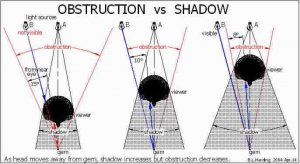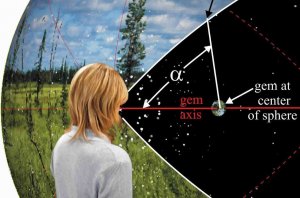. Many folks persist in using the word 'shadow' to describe blockage of light rays that could be reflected by the gem to the viewer's eye; indeed, I have done this myself on a few occasions. I think that this why some people miss the point.
. There is always a shadow, but this is not seen by the viewer; it has nothing to do with rays that are reflected to the viewer by the gem - they pass right through the shadow from a source to the gem.
. Here is an illustration based on the analogy provided by Derek Louey - as the head moves nearer to the stone the shadow decreases but the obstruction increases, and vice-versa.
. Please don't use the word 'shadow' for 'obstruction', 'blockage', or whatever you want to call it; this causes some people to miss the point.
. Would you believe that we just had an article rejected because the reviewer said that close-up view of a diamond is not important; it is only how it looks at a distance that matters! Perhaps he is right! Think about that.
. There is always a shadow, but this is not seen by the viewer; it has nothing to do with rays that are reflected to the viewer by the gem - they pass right through the shadow from a source to the gem.
. Here is an illustration based on the analogy provided by Derek Louey - as the head moves nearer to the stone the shadow decreases but the obstruction increases, and vice-versa.
. Please don't use the word 'shadow' for 'obstruction', 'blockage', or whatever you want to call it; this causes some people to miss the point.
. Would you believe that we just had an article rejected because the reviewer said that close-up view of a diamond is not important; it is only how it looks at a distance that matters! Perhaps he is right! Think about that.











300x240.png)